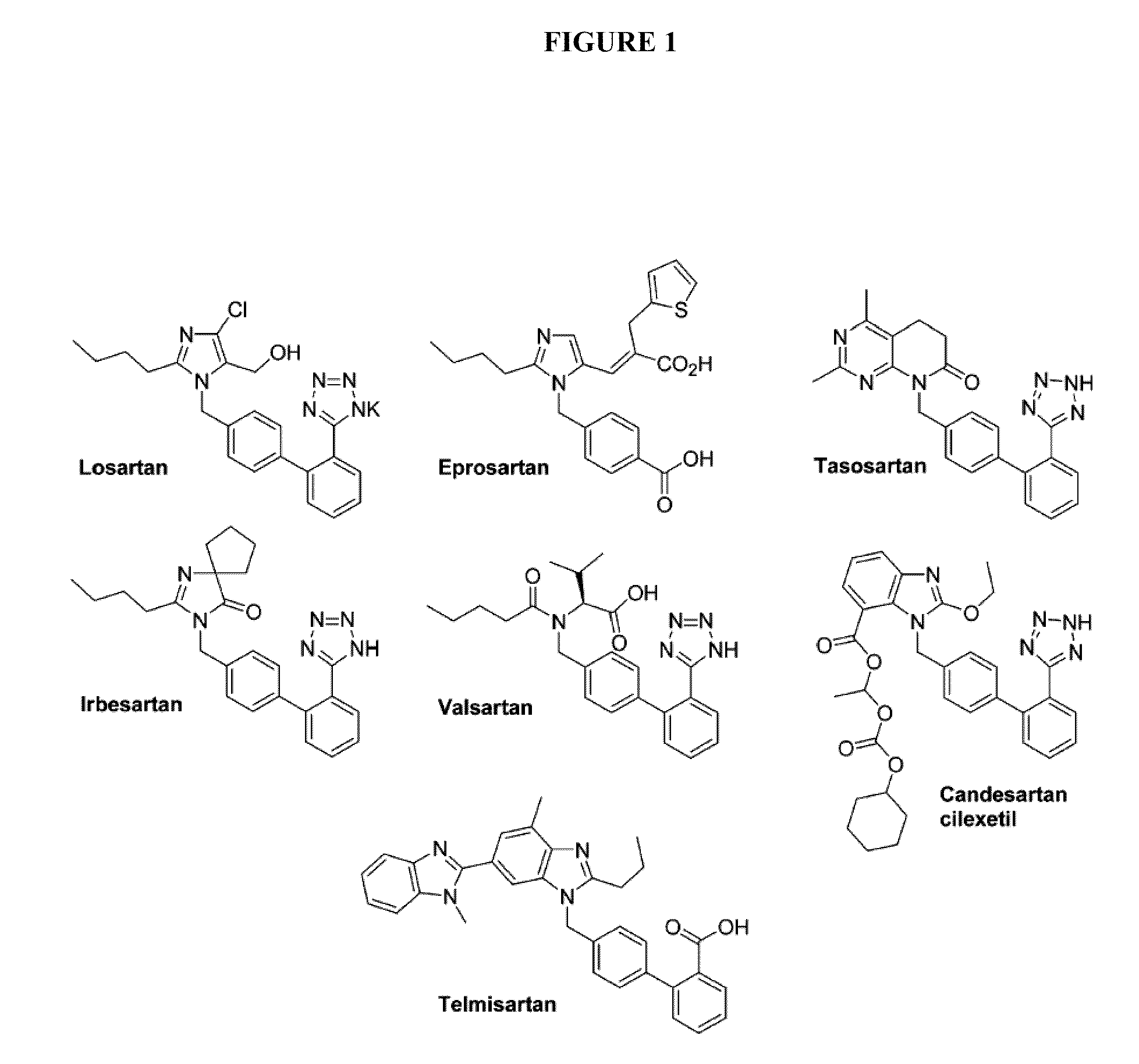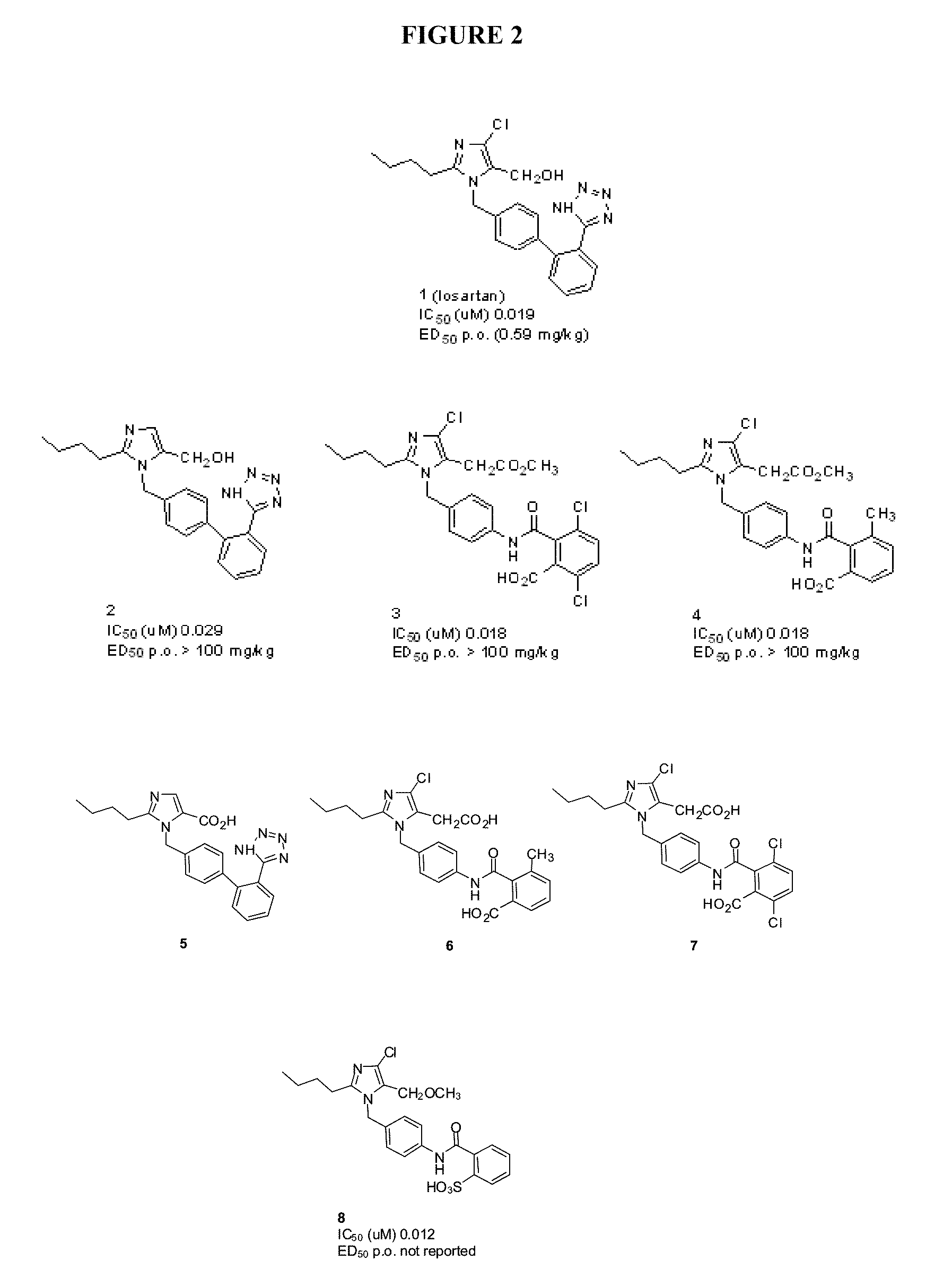Compositions and methods for treating inflammatory conditions of the bowel
a technology of inflammatory conditions and compositions, applied in the field of compositions and methods for treating inflammatory conditions, can solve the problems of poor success, little or no selectivity, and the immunologic aspects of the pathogenesis of ibd cannot answer the basic question, so as to prevent intestinal fibrosis and delay the progression of signs
- Summary
- Abstract
- Description
- Claims
- Application Information
AI Technical Summary
Benefits of technology
Problems solved by technology
Method used
Image
Examples
example 1
Design and characterization of AT1a Antagonists
[0166]Analogs that are closely related structurally to losartan (See, e.g., compound 1 in FIG. 2) and candesartan (See, e.g., FIG. 3, below) are provided. Each analog has structural attributes that render the molecules highly impermeable to cell membranes (both epithelial cells and adjacent vasculature). This limits the analogs' exposure in vivo to the intestine alone.
[0167]AT1a antagonists: Analogs 2, 3 and 4 are based on losartan 1 (See FIG. 2). Losartan analog 2 lacks the chloro group on the imidazole molecule and has hydrogen in its place. Losartan analog 3 lacks the chloro group on the imidazole molecule, and possesses a carboxylic acid instead of the hydroxylmethyl group. These changes are designed to yield very low intestinal absorption. Compound 5, similar to 2, lacks the chloro group on the imidazole molecule, and the hydroxymethyl group has been replaced by a carboxylic acid. Compounds 6 and 7, are similar to compounds 3 and 4...
example 2
Synthetic Strategy
[0170]A variety of synthetic routes utilized to generate analogs and / or derivatives are shown in FIGS. 5-7. For example synthesis schemes for losartan analogs and / or derivatives are shown in FIG. 5. The losartan analogue 2 is prepared from readily available losartan 1 in a single step by catalytic hydrogenolysis of the chloro group (See FIG. 5). In some embodiments, the analog 2 is readily oxidized to the novel carboxylic acid 5 with a manganese-based oxidizing agent. Compounds 3 and 4 (Shown in FIG. 6) are prepared starting with commercially available 2-butyl-4-hydroxymethyl-5-chloroimidazole 9. Diacids 6 and 7 are then obtained by simple saponification of the corresponding esters 4 and 3, respectively. Compound 8 is prepared by the route shown in FIG. 7, starting with compound 10 prepared in FIG. 4. The present invention can utilize a number of analytical methods (e.g., including, but not limited to, NMR, MS, HPLC and combustion analyses) to characterize the puri...
example 3
Screening and characterization of AT1a Antagonists
Materials and Methods
[0171]Animals. Specific pathogen-free male, 8-week old C57BL / 6 mice (Taconic Farms Inc, Germantown, N.Y.) were maintained in a 12-h night rhythm at 23° C. and a relative humidity of 40-60%. Animals were fed standard rodent chow (LabDiet 5001Rodent Diet, PMI Nutrition International, LLC, Brentwood, Mo.) ad libitum. All experiments were approved by the University Committee on Use and Care of Animals at the University of Michigan.
[0172]In vitro assessment of AT1aR antagonism. The present invention provides high throughput screening methods to detect AT1a antagonism in an in vitro setting. A variation of an in vitro model established by McAllister-Lucas et al. (See, e.g., McAllister-Lucas et al., PNAS, 2007; 104:139-44) was used to measure the degree of antagonism on AT1a receptor signaling. This model makes use of the fact that Ang II-dependent stimulation of the AT1a receptor results in rapid activation of the NF-κ...
PUM
| Property | Measurement | Unit |
|---|---|---|
| Body weight | aaaaa | aaaaa |
Abstract
Description
Claims
Application Information
 Login to View More
Login to View More - R&D
- Intellectual Property
- Life Sciences
- Materials
- Tech Scout
- Unparalleled Data Quality
- Higher Quality Content
- 60% Fewer Hallucinations
Browse by: Latest US Patents, China's latest patents, Technical Efficacy Thesaurus, Application Domain, Technology Topic, Popular Technical Reports.
© 2025 PatSnap. All rights reserved.Legal|Privacy policy|Modern Slavery Act Transparency Statement|Sitemap|About US| Contact US: help@patsnap.com



